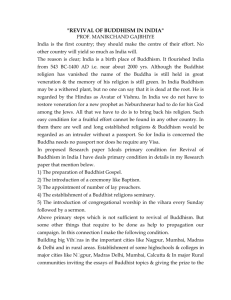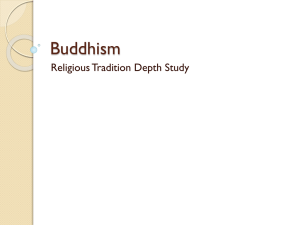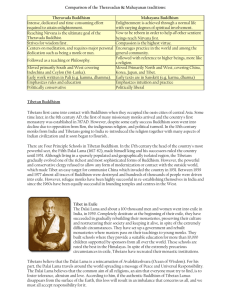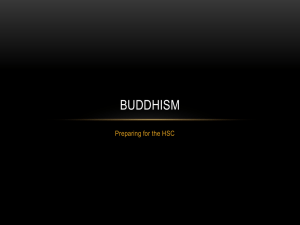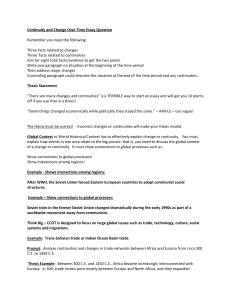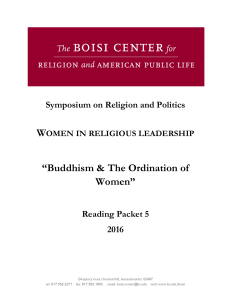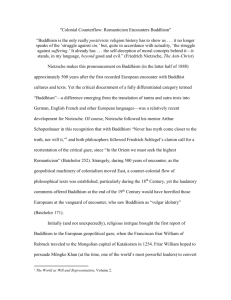Rise of Ayudha (Ayuthiya)
advertisement
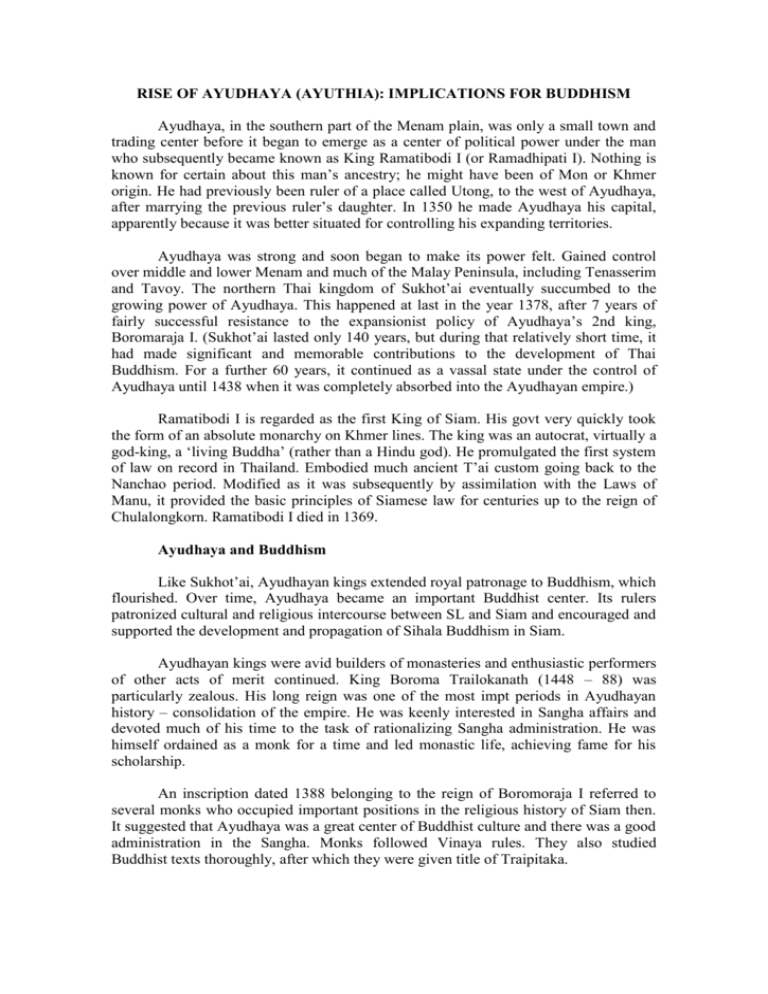
RISE OF AYUDHAYA (AYUTHIA): IMPLICATIONS FOR BUDDHISM Ayudhaya, in the southern part of the Menam plain, was only a small town and trading center before it began to emerge as a center of political power under the man who subsequently became known as King Ramatibodi I (or Ramadhipati I). Nothing is known for certain about this man’s ancestry; he might have been of Mon or Khmer origin. He had previously been ruler of a place called Utong, to the west of Ayudhaya, after marrying the previous ruler’s daughter. In 1350 he made Ayudhaya his capital, apparently because it was better situated for controlling his expanding territories. Ayudhaya was strong and soon began to make its power felt. Gained control over middle and lower Menam and much of the Malay Peninsula, including Tenasserim and Tavoy. The northern Thai kingdom of Sukhot’ai eventually succumbed to the growing power of Ayudhaya. This happened at last in the year 1378, after 7 years of fairly successful resistance to the expansionist policy of Ayudhaya’s 2nd king, Boromaraja I. (Sukhot’ai lasted only 140 years, but during that relatively short time, it had made significant and memorable contributions to the development of Thai Buddhism. For a further 60 years, it continued as a vassal state under the control of Ayudhaya until 1438 when it was completely absorbed into the Ayudhayan empire.) Ramatibodi I is regarded as the first King of Siam. His govt very quickly took the form of an absolute monarchy on Khmer lines. The king was an autocrat, virtually a god-king, a ‘living Buddha’ (rather than a Hindu god). He promulgated the first system of law on record in Thailand. Embodied much ancient T’ai custom going back to the Nanchao period. Modified as it was subsequently by assimilation with the Laws of Manu, it provided the basic principles of Siamese law for centuries up to the reign of Chulalongkorn. Ramatibodi I died in 1369. Ayudhaya and Buddhism Like Sukhot’ai, Ayudhayan kings extended royal patronage to Buddhism, which flourished. Over time, Ayudhaya became an important Buddhist center. Its rulers patronized cultural and religious intercourse between SL and Siam and encouraged and supported the development and propagation of Sihala Buddhism in Siam. Ayudhayan kings were avid builders of monasteries and enthusiastic performers of other acts of merit continued. King Boroma Trailokanath (1448 – 88) was particularly zealous. His long reign was one of the most impt periods in Ayudhayan history – consolidation of the empire. He was keenly interested in Sangha affairs and devoted much of his time to the task of rationalizing Sangha administration. He was himself ordained as a monk for a time and led monastic life, achieving fame for his scholarship. An inscription dated 1388 belonging to the reign of Boromoraja I referred to several monks who occupied important positions in the religious history of Siam then. It suggested that Ayudhaya was a great center of Buddhist culture and there was a good administration in the Sangha. Monks followed Vinaya rules. They also studied Buddhist texts thoroughly, after which they were given title of Traipitaka. But there were pockets in its history when the Ayudhayan kings were distracted by wars to be focused on promoting Buddhism. Early in their history, they were caught up with expanding the empire – fighting Nabbisipura and Angkor. In the 16th century, they were busy fighting off the Burmans. King Maha Chakrap’at (1549-64) had to defend his kingdom against a large Burmese army led by Tabinshwehti (1531-50) of the Toungoo dynasty. Then came Bayinnaung (1551-81) of Pegu, who attacked Ayudhaya twice. Such crisis were detrimental to the cause of Buddhism. Ayudhaya finally had peace during the reign of Pra Naret, who ascended the throne in 1590 and is known in history as Naresuen. Bayinnaung’s son Nanda Bayin attacked Ayudhaya unsuccessfully 5 times during Naresuen’s reign. The latter turned the table on the Burmese and successfully attacked Pegu and went on to invade and conquer Cambodia. He revived Buddhism in his kingdom. Religious intercourse with SL 18th century witnessed a new chapter in relations between SL and Ayudhaya. King Boromokot ascended throne in 1733. His reign was known as a golden age in Siamese history – peaceful and prosperous. Relations with Burma were very friendly. Devout Buddhist and personally interested in welfare of Buddhism. constructed many monasteries throughout his kingdom. During his reign, Ayudhaya became a great center of Buddhism. SL sent monks to Ayudhaya to get assistance to restore higher ordination in the island. * Boromokot received the Sinhalese envoys warmly and was moved to offer his help when he heard about the decline of Buddhism in SL. He consulted the Siamese Sangharaja and learned monks and with their concurrence, selected 10 monks to go to SL, according to the Culavamsa. 3 Siamese ambassadors went along. Leader of the delegation was Upali Mahathera. He also sent a golden image of the Buddha,a golden book, a royal letter in Pali and other gifts. Boromokot died in 1758. His son and successor was the last king to rule at Ayudhaya. Less than 10 years later in 1767, the Burmese king Alaungpaya attacked Ayudhaya and destroyed it.

